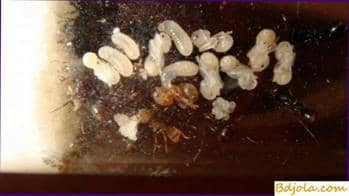Dead brood

The dead brood is an infectious disease, accompanied by extinction of the brood at different stages of development.
Causes of the disease. The disease has a common etiologic stagnation; the uterus reproduces the non-viable offspring.
Course of the disease. The disease can be observed throughout the summer. According to EV Arefiev, this disease is associated with heredity of producers, transmitted through the male line through a drones. It is possible that the appearance of frozen brood is also affected by the inferiority of feeding. The underfeeding of the larvae leads to a decrease in the size of the bees and to their death in the stage of pupae or young bees.
Symptoms of the disease. The brood dies in the stage of an unsealed and sealed larva or in the pupal stage. The lids of sealed cells with a dead brood are often perforated and resemble foulbrood. The larvae, which did not have time to turn into pupae, are soft, moist and easily removed from the cells. Larvae have a grayish hue, slightly viscous, as they dry up they turn brown.
They do not smell or sometimes emit a sour smell. The most characteristic sign is the death of the brood in various stages of the pupae (white and pigmented), ready to exit from the cells, which is not the case with infectious diseases of brood. Killed pupae are often small in size, especially the abdominal part is underdeveloped.
Removed from the cells of corpses of such pupae can be found before the hive of the hive on the ground. The severity of brood damage can be very diverse: from single cases on the honeycomb to significant amounts. Sometimes perish, not only bees, but also drone forms. And the death can be not only in the stage of brood, but also in the stage of bees that have recently emerged from the cells. The latter come with an underdeveloped abdomen and wings and can not fly. Such bees do not stay in the hive for a long time. They are thrown out by flying bees; Thus, the underdevelopment of young bees has a genetic connection with the frozen brood and with a dead seeding.
The diagnosis is based on the external characteristics of the deceased brood, and if necessary, specified by laboratory research.
Prevention. The disease is prevented by eliminating the related dilution. Heterosis simultaneously prevents frozen brood and increases the productivity of bee colonies.
Control measures. Replace the uterus, reproducing the dead brood, provide bees with sufficient amount of benign honey and pergoy.
Dead brood
